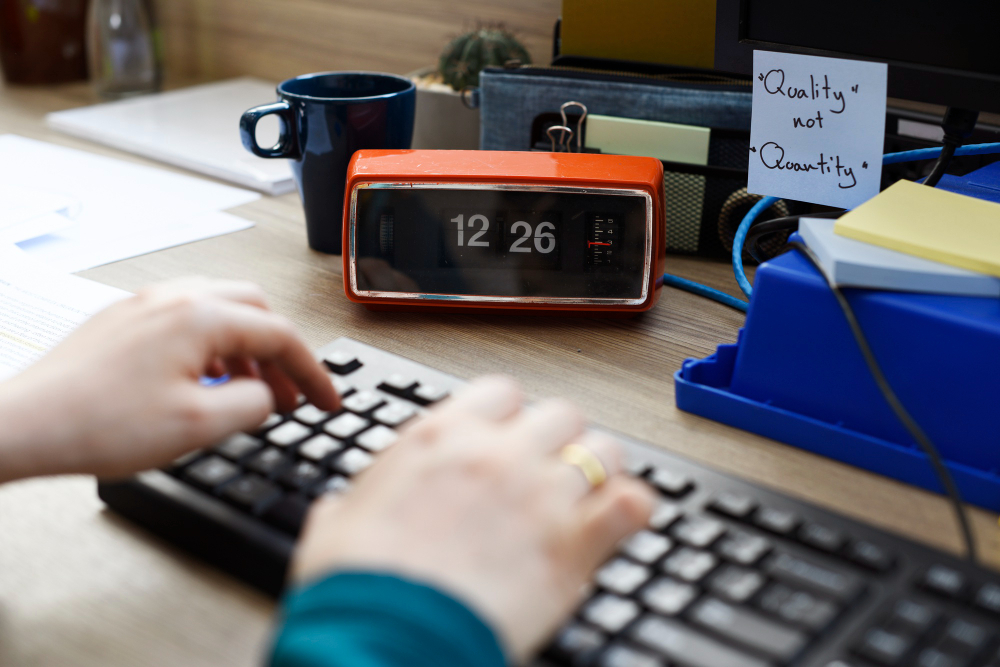
In today’s rapidly evolving digital age, screens have become an integral part of our everyday routines. and that number only increases when work and leisure are combined. While technology enables efficiency, creativity, and global communication, it also creates a paradox: we are always on, and the line between work and rest is increasingly blurred. Learning how to balance screen time and work is not just about digital discipline—it’s about protecting your productivity, mental well-being, and physical health. In this guide, we’ll explore why screen time management matters, the warning signs of screen fatigue, and practical strategies for balancing screen time and work in the digital age.

The Importance of Balancing Screen Time and Work
Before diving into solutions, it’s essential to understand why balancing screen time and work is so critical.
1. Physical Health Risks
Prolonged screen exposure contributes to:
- Eye strain (Computer Vision Syndrome)
- Poor posture and back pain
- Headaches and sleep disturbances
- Sedentary lifestyle-related issues like obesity, heart disease, and metabolic syndrome
2. Mental Health Implications
Too much screen time, especially without boundaries, can lead to:
- Burnout and cognitive fatigue
- Increased anxiety and depression
- Reduced attention span and focus
- Poor sleep quality due to blue light exposure
3. Productivity Paradox
While screens power most modern jobs, multitasking between emails, messages, apps, and tabs creates the illusion of productivity but often results in:
- Reduced deep work and focus
- More mistakes and slower task completion
- Digital distractions outweighing work progress
In short, without managing screen usage wisely, even the most talented professionals may find themselves overwhelmed, underproductive, and stressed out.
Signs You Need Better Screen Time Balance
It’s easy to slip into unhealthy screen habits, especially with remote work and always-on smartphones. Here are some red flags:
- You feel mentally drained even after short tasks
- You have difficulty focusing on non-screen activities
- You check your phone compulsively during breaks
- You experience screen-induced insomnia or difficulty sleeping
- You work longer hours but accomplish less
Recognizing these signs is the first step toward balancing screen time and work more effectively.
Strategies to Balance Screen Time and Work
Let’s now explore actionable strategies that help you take back control of your digital life without sacrificing productivity.
1. Set Digital Boundaries with Work Hours
Remote work has made it harder to define when work ends. Create digital limits:
- Set clear start and stop times for your workday.
- Use Do Not Disturb or Focus Modes after work hours.
- Avoid checking work emails or messages outside of work time.
By drawing clear boundaries, you signal your brain to shift from work mode to rest mode, minimizing screen overexposure.
2. Follow the 20-20-20 Rule
To prevent eye strain:
- Every 20 minutes, look at something 20 feet away for 20 seconds.
- This simple habit can reduce digital eye strain and dry eyes caused by screen glare and blinking less frequently.
Tip: Set an alarm or use browser extensions like EyeCare or Stretchly to remind you.
3. Embrace Task Batching
Avoid the “always switched-on” multitasking mode. Instead:
- Group similar tasks (emails, meetings, content creation) into focused blocks.
- Schedule screen-free buffers between tasks.
- This minimizes context switching and ensures you’re not bouncing between tabs all day long.
4. Take Intentional Screen-Free Breaks
Make your breaks truly refreshing by going screen-free:
- Walk around the block
- Do a short workout or stretch session
- Meditate or practice breathing exercises
- Chat with someone in person
These off-screen activities not only refresh your body but also reset your focus.
5. Use Tech to Fight Tech Overuse
Paradoxically, technology can help limit technology:
- Use apps like Freedom, Focus@Will, or RescueTime to monitor and block distractions.
- Enable grayscale mode or screen time limits on phones to reduce dopamine-driven scrolling.
- Use blue light filters like f.lux or Night Shift to ease eye strain in the evenings.
Balancing screen time and work doesn’t always mean cutting out screens—it means using them more mindfully.
6. Redesign Your Digital Environment
Your workspace plays a huge role in screen habits. Optimize it:
- Use ergonomic setups: eye-level screens, standing desks, wrist support.
- Keep your phone out of reach or in a drawer.
- Turn off non-essential notifications to avoid micro-distractions.
A well-curated digital workspace fosters focus and prevents screen overload.
7. Try the Pomodoro Technique
The Pomodoro Technique (25 minutes of work, 5-minute break) encourages focused screen time followed by deliberate pauses.
- Use tools like Pomofocus or Forest App.
- During breaks, avoid screens—stretch, hydrate, or rest your eyes.
This rhythm balances high productivity bursts with regular mental resets.
8. Engage in Screen-Free Hobbies
Reignite offline passions:
- Reading physical books
- Gardening, cooking, or journaling
- Art, DIY crafts, or playing a musical instrument
These hobbies allow your brain to recover from cognitive load, enhance creativity, and prevent screen dependence.
9. Make Sleep Sacred (and Screen-Free)
Uncontrolled screen time often takes a toll on sleep quality, making it one of the most affected aspects of our health. Improve sleep hygiene by:
- Avoiding screens 1–2 hours before bed
- Keeping your phone out of the bedroom
- Reading a book or meditating instead of doomscrolling
Your sleep is when your brain recharges. Balancing screen time and work starts with good rest.
10. Normalize Digital Detoxes
Consider:
- Screen-free weekends or half-days
- Tech-free meals and conversations
- “No-screen” hours each evening
Periodic digital detoxes help rewire your relationship with screens and restore mental clarity.
Balancing Screen Time in Different Work Environments
Remote Workers
- Schedule outdoor breaks and social interactions.
- Use two-monitor setups to reduce constant tab switching.
- Log off from work platforms after hours.
Office Workers
- Avoid working through lunch at your desk.
- Stand up every hour—even for 2 minutes.
- Use printed documents or offline brainstorming sessions when possible.
Freelancers/Entrepreneurs
- Stay aware when long screen hours are masking a lack of real progress.
- Limit client communications to certain hours.
- Set app usage quotas—especially for social media or video platforms.
For Managers and Team Leaders: Promoting Healthy Screen Habits
If you’re in a leadership role, encourage healthy practices:
- Avoid after-hours emails or chat messages.
- Promote asynchronous communication to reduce real-time pressure.
- Lead by example—take screen breaks, respect offline time, and encourage well-being over always-on culture.
A healthy team is a productive team—and balancing screen time and work at an organizational level leads to long-term success.
The Future of Work and Screen Time
As AI, remote tools, and the metaverse shape the future of work, our relationship with screens will evolve further. However, the fundamentals remain the same:
- Screen time should serve your productivity, not define your day.
- True balance means understanding when to plug in—and when to unplug.
- Companies and individuals alike must adapt with healthy digital boundaries in mind.
Final Thoughts: The Real Goal of Screen-Life Balance
Balancing screen time and work isn’t about eliminating technology—it’s about creating a healthier, more intentional relationship with it.
When used mindfully, screens are incredible tools for growth, connection, and innovation. But boundaries give us freedom—freedom to think, move, breathe, and live beyond the pixels.
Start small. Shift one habit. Take one screen-free walk. Reclaim one hour of rest.
You don’t need a complete digital overhaul. Just a commitment to living—and working—with more clarity and control in the digital age.




